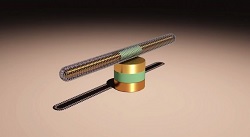 |
| The nanomotor spins to move forward and deliver drugs.--Courtesy of UT Austin |
Mobility is an important function of any drug-delivering robot--even a well-designed machine that ultimately can't get where it's needed serves little to no purpose. To this end, researchers have developed a wide range of innovative devices from microrockets to DNA propellers to sperm-driven robots.
Now, researchers at the University of Texas at Austin have built what promises to be the smallest, fastest and longest running synthetic motor yet made, according to a report from the university. And although they haven't incorporated them into delivery devices currently, these motors could one day find their way into the smallest nanorobots still in development.
The mechanical engineers created a three-part nanomotor that uses biochemicals to pump itself (and any vehicle attached to it) through liquids, the team published in the journal Nature Communications. And with these mechanisms in place, the motor can run for up to 15 hours at 18,000 rotations per minute, much faster than any others of its size.
For drug delivery, the team envisions its nanomotor carrying vehicles for insulin or cancer drugs. To test this capability, they coated the motor with chemicals to mimic the release of drugs, and the faster the motor spun, the faster it released the chemicals.
 |
| Donglei Fan |
"We were able to establish and control the molecule release rate by mechanical rotation, which means our nanomotor is the first of its kind for controlling the release of drugs from the surface of nanoparticles," lead author Donglei Fan said in a statement. "We believe it will help advance the study of drug delivery and cell-to-cell communications."
The next step is to use the minuscule motors near a live cell to see how they interact and to measure the release of chemicals in a treatment scenario.
- here's the UT Austin report
- and the research abstract